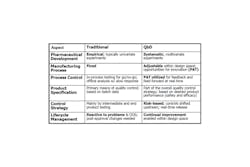Ten years ago the U.S. Food and Drug Administration created “A Vision for 21st Century Manufacturing.” FDA wanted an efficient, flexible pharmaceutical manufacturing sector producing high-quality drugs without extensive regulatory oversight. Today, FDA is establishing an Office of Pharmaceutical Quality to improve the agency’s scrutiny of brand-name, generic and over-the-counter drugs and is calling on industry to offer up metrics to prioritize field investigations, said Russell Wesdyk, scientific coordinator for FDA’s Office of Pharmaceutical Science.
According to Wesdyk, there has been a “tremendous increase” in field alert reports, recalls have increased dramatically, and drug shortages due to component problems, delays and capacity issues are increasing as well. Industry itself is ultimately responsible for quality, but “alerts, recalls and shortage data do not bare out that we are making progress yet—despite what drug makers say about improvements in quality,” he said.
According to Wesdyk, the agency is thinking that compliance to good manufacturing practices (GMPs) has overshadowed concentrating on quality—quality of the process, the batch, the packaging and other aspects of the supply chain.
“Take a cancer patient on a pretty special drug,” said Wesdyk. “The plant is registering 50 percent of batches failing. Does that sound like a validated process to you? [When that many batches are failing,] you start running into availability issues. But a Form 483 is not going to get that drug in the patient’s hands and faster.” Form FDA 483 is used by the FDA to document and communicate concerns discovered during inspections.
The FDA’s cGMP for the 21st Century initiative is driving the industry to change its development and manufacturing to be based on process understanding and a risk-based approach. This new paradigm uses terminology such as Quality by Design (QbD), continued process verification (CPV), and process analytical technology (PAT). This has a significant impact on the methods and tools for process control, according to Jonathan Lustri, Emerson Process Management life sciences industry consultant.
In an excellent post in Jim Cahill’s blog, Lustri says the state of the art capability is to develop a multivariate model that describes “the process design space.” Traditional pharmaceutical manufacturing is focused on repeating a fixed recipe and controlling the recipe parameters to fixed setpoints. The QbD strategy, on the other hand, changes this to operate the process within a defined design space.
“This results in more robust manufacturing producing higher quality. The traditional approach does not allow the flexibility to control the process to respond to unavoidable variability,” Lustri says.
Process validation is also impacted by the new paradigm. The FDA has issued a new validation guidance document that encourages Continued Process Verification. Lustri says traditional validation methods relied on the principle of a manufacturer being able to prove that it could repeatably produce quality product by following a fixed procedure within specified equipment. If this was demonstrated, the process was considered validated.
“Under the new guidance, validation is based on the principle that the manufacturer can establish scientific evidence that the process is capable of consistently producing product quality. One aspect of this is the use of continuous process verification to provide on-going assurance during routine production that the process is in a state of control and producing quality product,” Lustri explains.
The problem today, according to FDA’s Wesdyk, is that there are no objective measures to track to see if quality is improving. “Quality standards just don't exist,” he contends. “You can see the remarkable level of variability with FDA data, in how it’s collected and even in who is analyzing it. [But] we have to be efficient…. Can we establish an adequacy for downgrading, where meaningful metrics demonstrate the FDA can back off on inspections?”
Both the agency and industry have a general consensus on some baseline acceptable metrics, but FDA is still seeking opinions. “We recognize there is a long road ahead,” said Wesdyk.
About the Author
Renee Bassett
Managing Editor

Leaders relevant to this article:
